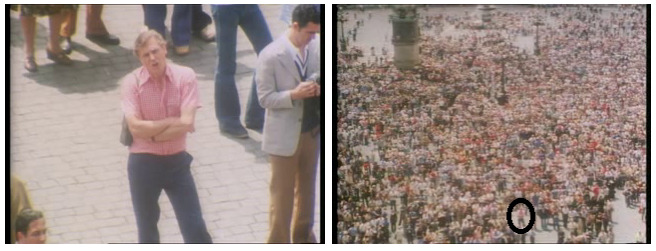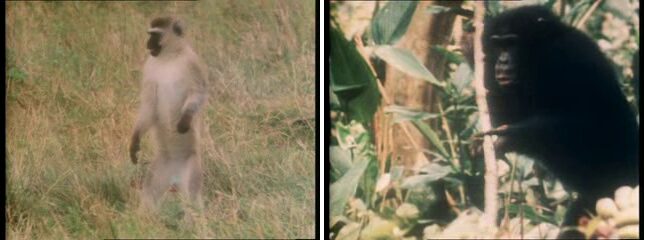Original air date: 10 April 1979
This final episode is completely different from the all the previous ones; it is about only one species – humans. Ironically, it wasn’t even written by David Attenborough himself. His son, the anthropologist Robert Attenborough, wrote the script for this one.
As the image below shows the episode is basically split into three parts.

The final episode at a glance, a more detailed version can be seen below

It inevitably starts in Africa and ends up in modern times.
Selected material:
Introducing the episode

Strangely, one of the most memorable sequences is the one at the very beginning where Attenborough is talking from a crowd of people. The cameraman has zoomed in from very far away. The episode actually starts by showing people communicating for some 40 seconds before Attenborough starts talking from the crowd. He has already been speaking for half a minute (and stuttered a few times) before the cameraman starts zooming out. The problem is that he has to learn a very lengthy text to speak and has no way of leaving any notes to have a look at when there is something he doesn’t remember. When zooming out the camera would reveal any such cheat sheets for almost a whole 60 seconds!
Retracing the steps of early humans
Leaving the trees

First steps in leaving the trees meant being vulnerable to dangers. In addition to harmless herds (of grass eaters) there were hunters around. Best way to avoid them would be to rise up on their hind legs (as the vervets tend to do for the same purpose, left image). Still early men would sometimes need to defend themselves. They weren’t very strong so they would need some weapons like chimpanzees tend to use – being the only animals to use tools as defence, 6’58).
Claiming somebody else’s meat for yourself

In the first snapshot (top left), Attenborough scares off a few vultures. Next (top right) he attempts to cut open the beast that, prior to this part lions seemed to have killed. Bottom left he shows how a normal stone is manipulated so that it can have a cutting edge. In the last image he shows that all you need to survive out in the open plains is a stick to scare off animals, a stone to cut the animal and a pair of manipulative hands (10′-11’20).
Attenborough’s references his own earlier works. Including a scene from “Blob on the Map” (17’45-22’10).
A second sequence is actually a couple of those. Late in the episode Attenborough talks about the start of writing just before he mentions the discovery of the DNA. If this was a few decades more recent people might take the extra hint that DNA was also being used there because it has turned out to be a very good way of condensing information, like the written word. They probably didn’t know it at that time.
Final words: “This is the last programme in this natural history, and it’s very different from the others because it’s been devoted to just one animal: ourselves. And that may have been a misleading thing to have done. It may have given the impression that man was the ultimate triumph of evolution, that all those thousands of millions of years of development had no purpose other than to put man on earth. There is no scientific evidence whatsoever for such a belief. No reason to suppose that man’s stay on earth should be any longer than that of the dinosaurs. He may have learned to control his environment, to pass on information from one generation to another, but the forces of evolution that brought him into existence here on these African plains are still at work elsewhere in the world and if man were to disappear, for whatever reason, there is doubtless somewhere some small, unobtrusive creature that would seize the opportunity and, with a spurt of evolution, take man’s place. But although denying a special place in the world may be becomingly modest, the fact remains that man has an unprecedented control over the world and everything in it. And so, whether he likes it or not, what happens next is very largely up to him.“
Filming locations:
The first sequence, apart from the crowded starting one, is filmed somewhere in Africa (3’15)
France, showing the advancement of humans early on (23′)
Attenborough follows the story of human kind to Iraq (37’30)
Other filming locations:
Aborigines in Australia and bushmen in Kalahari (33′)
People suffering from too little sunshine in Lapland (34’30) and the descendants of Asians in South American rainforests (35′)